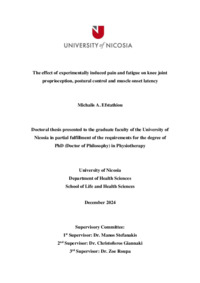- Efstathiou, Michalis
- School of Life and Health Sciences
- Department of Health Sciences
- English
- 129
- Giannaki, Christoforos | Roupa, Zoe | Stefanakis, Manos
- Knee joint | Proprioception | Joint position sense | Experimentally induced pain | Experimentally induced fatigue
- Proprioception -- Experimentally induced pain
-
-
Background: Proprioception plays an important role in knee joint function. Despite the possible
influence of pain and peripheral fatigue on the proprioceptive system, postural control and muscle
activity, the effects of experimental muscle pain and fatigue on these variables have not been
studied sufficiently.
Objectives: The purpose of this thesis was twofold: Initially, to investigate if experimentally induced
muscle pain affects knee joint position sense (JPS), movement sense, postural control and muscle
onset latency in healthy participants. Lastly, to investigate if experimentally induced fatigue affects
knee JPS, movement sense and muscle onset latency in healthy subjects.
Methods: In order to study the effects of experimentally induced pain, a pre-test-post-test design
was conducted to measure knee JPS, movement sense, postural control and muscle onset latency
before and after the injection of 5.8% sterile hypertonic saline in the vastus medialis muscle of 26
healthy, physically active adult participants. Knee JPS was assessed through an ipsilateral active
reproduction of passive positioning paradigm in target angles of 60°, 45° and 15° from a start
position of 90° with the use of an isokinetic dynamometer. Absolute and relative angular errors were
calculated. The coefficient of variation analysis was used to assess differences in the variability
during the reproduction of the three angles. Movement sense was measured using the threshold to
detection of passive motion on the isokinetic dynamometer. Postural control was measured
through a balance board system. Finally, muscle onset latency of the vastus medialis and vastus
lateralis muscles was measured. In order to assess the effect of fatigue, a pre-test–post-test design
3
was conducted to measure knee JPS, movement sense, and muscle onset latency before and
after an experimental fatigue protocol in 30 healthy, physically active, adult participants. Knee JPS
was assessed through an ipsilateral active reproduction of passive positioning paradigm in target
angles of 45°, 30° and 15° from a start position of 60° with the use of an isokinetic dynamometer.
Absolute and relative angular errors were calculated. The coefficient of variation analysis was used
to assess differences in the variability during the reproduction of the three angles. Movement sense
was measured using the threshold to detection of passive motion on the isokinetic dynamometer.
Finally, muscle onset latency of the biceps femoris and semitendinosus muscles was measured.
Results: There was an increase in absolute angular error in all three angles following experimentally
induced pain. The difference was statistically significant at 45° (p<0.05, d=0.63) and 15° (p<0.05,
d=0.41) but not at 60° (p=0.064, d=0.38). Relative error did not show directional bias at 45° (p=0.27,
d=0.21), 15° (p=0.48, d=0.14) or 60° (p=0.09, d=0.34). The coefficient of variation analysis revealed a
statistically significant reduction in variability during the repositioning test at angles of 60° (p<0.05,
d=0.67) and 15° (p<0.05, d=0.44) after the pain intervention. The TTDPM scores showed statistically
significant differences for both flexion (p<0.01, d=1.07) and extension (p<0.001, d=0.99), indicating
that response latency significantly increased for flexion and extension after the pain intervention.
The muscle onset latency scores for both the VMO and VLO muscles did not reach statistical
significance after the pain induction. Balance stability scores did not show statistically significant
differences; however, path length scores were statistically significantly higher after pain induction
(z=245, p=0.007). There was an increase in absolute angular error in all three angles following
muscle fatigue. The difference was statistically significant at 45° (p<0.001, d=1.24), 30° (p<0.001,
d=1.2) and 15° (p<0.001, d =0.77). Relative error did not show directional bias at 30° (p=0.48, d=0.14)
or 15° (p=0.09, d=0.34), however a statistically significant bias towards flexion was observed at 45°
(p=0.01, d=0.21). The coefficient of variation analysis revealed a statistically significant reduction in
variability during the repositioning test at 45° (p<0.001, d=0.72), 30° (p<0.001, d=0.68) and 15°
(p=0.004, d=0.56) after the fatigue intervention. The TTDPM scores showed statistically significant
differences for both flexion (p<0.001, d=1.34) and extension (p<0.001, d=0.95), indicating that
response latency significantly increased for flexion and extension after fatigue. The muscle onset
latency scores for both the hamstrings and semitendinosus muscles did not reach statistical
significance after the fatigue intervention.
Conclusion: The presence of experimentally induced muscle pain affects the ability of healthy,
physically active, adults to accurately reposition the knee, disrupts movement sense for flexion and
extension and reduces movement variability during the repositioning task. The current research
highlights the importance of considering knee proprioceptive deficiencies in patients with knee
pain. Experimentally induced fatigue affects healthy young individuals' ability to accurately
reposition the knee, disrupts movement sense for flexion and extension and reduces movement
variability during the repositioning task. The results highlight the importance of assessing knee
proprioception and fatigue in athletes and implementing fatigue-preventative exercise programs.
-

